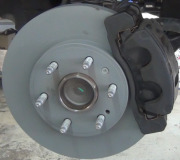The first thing to suspect is the pressurized brake fluid is being trapped somewhere and can't release back to the reservoir. To verify that, raise that wheel off the ground when it is locking up, and open the bleeder screw on that caliper. If that lets that brake release, we'll have to repeat the procedure by opening that hydraulic circuit in other places to determine where the line is blocked.
If opening the system works no matter where you open it, even all the way back to the master cylinder, it is likely the brake fluid has become contaminated with a petroleum product. That will cause all the rubber seals and all the other rubber parts that contact the brake fluid to swell. That gets to be a very expensive repair. A clue to petroleum contamination is when you remove the cap from the reservoir, the rubber bladder seal will be blown up and mushy, and you will find it very difficult to get the cap back on.
If opening the bleeder screw on the caliper does not let the brake release, that caliper is sticking. First inspect the mounting hardware for damage or rusted parts that are preventing the caliper from sliding freely. Use a large flat-blade screwdriver to try to pry the piston back into the caliper housing. Some force will be needed, but it should slide fairly easily by hand. If you can't retract the piston, even with the bleeder screw open, that caliper must be replaced or rebuilt. We always replace or rebuild both at the same time to maintain balanced brakes.
Saturday, September 26th, 2020 AT 6:05 PM




